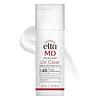What's inside
What's inside
 Key Ingredients
Key Ingredients

 Benefits
Benefits

 Concerns
Concerns

 Ingredients Side-by-side
Ingredients Side-by-side

Zinc Oxide 9%
Cosmetic ColorantEthylhexyl Methoxycinnamate 7.5%
UV AbsorberWater
Skin ConditioningCyclopentasiloxane
EmollientNiacinamide
SmoothingOctyldodecyl Neopentanoate
EmollientHydroxyethyl Acrylate/Sodium Acryloyldimethyl Taurate Copolymer
Emulsion StabilisingButylene Glycol
HumectantPhenoxyethanol
PreservativePolyisobutene
Triethoxycaprylylsilane
Tocopheryl Acetate
AntioxidantPEG-7 Trimethylolpropane Coconut Ether
EmulsifyingOleth-3 Phosphate
Iodopropynyl Butylcarbamate
PreservativeLactic Acid
BufferingSodium Hyaluronate
HumectantPhosphoric Acid
BufferingZinc Oxide 9%, Ethylhexyl Methoxycinnamate 7.5%, Water, Cyclopentasiloxane, Niacinamide, Octyldodecyl Neopentanoate, Hydroxyethyl Acrylate/Sodium Acryloyldimethyl Taurate Copolymer, Butylene Glycol, Phenoxyethanol, Polyisobutene, Triethoxycaprylylsilane, Tocopheryl Acetate, PEG-7 Trimethylolpropane Coconut Ether, Oleth-3 Phosphate, Iodopropynyl Butylcarbamate, Lactic Acid, Sodium Hyaluronate, Phosphoric Acid
Water
Skin ConditioningEthylhexyl Methoxycinnamate
UV AbsorberOctocrylene
UV AbsorberDiisopropyl Adipate
EmollientAlcohol Denat.
AntimicrobialBis-Ethylhexyloxyphenol Methoxyphenyl Triazine
Skin ConditioningButyl Methoxydibenzoylmethane
UV AbsorberSilica
AbrasiveMethylene Bis-Benzotriazolyl Tetramethylbutylphenol
UV FilterC15-19 Alkane
SolventIsostearyl Alcohol
EmollientButylene Glycol Cocoate
EmulsifyingPropylene Glycol
HumectantCapryloyl Glycerin/Sebacic Acid Copolymer
Skin ConditioningTitanium Dioxide
Cosmetic ColorantPolyacrylate Crosspolymer-6
Emulsion StabilisingDicaprylyl Carbonate
EmollientBis-Ethylhexyl Hydroxydimethoxy Benzylmalonate
AntioxidantHelianthus Annuus Seed Oil
EmollientLupinus Albus Seed Extract
Skin ConditioningRosmarinus Officinalis Leaf Extract
AntimicrobialPlankton Extract
Skin ConditioningSodium Hyaluronate
HumectantArgania Spinosa Kernel Oil
EmollientPersea Gratissima Oil
Skin ConditioningLecithin
EmollientHydroxytyrosol
BleachingDimethicone
EmollientEthylhexylglycerin
Skin ConditioningSucrose
HumectantLactic Acid
BufferingTocopherol
AntioxidantTocophersolan
AntioxidantButyl Methacrylate/Acryoyloxy Pg Methacrylate Copolymer
Glycerin
HumectantPropanediol
SolventDecyl Glucoside
CleansingEthylcellulose
Xanthan Gum
EmulsifyingTetrasodium Glutamate Diacetate
Phenoxyethanol
PreservativeParfum
MaskingWater, Ethylhexyl Methoxycinnamate, Octocrylene, Diisopropyl Adipate, Alcohol Denat., Bis-Ethylhexyloxyphenol Methoxyphenyl Triazine, Butyl Methoxydibenzoylmethane, Silica, Methylene Bis-Benzotriazolyl Tetramethylbutylphenol, C15-19 Alkane, Isostearyl Alcohol, Butylene Glycol Cocoate, Propylene Glycol, Capryloyl Glycerin/Sebacic Acid Copolymer, Titanium Dioxide, Polyacrylate Crosspolymer-6, Dicaprylyl Carbonate, Bis-Ethylhexyl Hydroxydimethoxy Benzylmalonate, Helianthus Annuus Seed Oil, Lupinus Albus Seed Extract, Rosmarinus Officinalis Leaf Extract, Plankton Extract, Sodium Hyaluronate, Argania Spinosa Kernel Oil, Persea Gratissima Oil, Lecithin, Hydroxytyrosol, Dimethicone, Ethylhexylglycerin, Sucrose, Lactic Acid, Tocopherol, Tocophersolan, Butyl Methacrylate/Acryoyloxy Pg Methacrylate Copolymer, Glycerin, Propanediol, Decyl Glucoside, Ethylcellulose, Xanthan Gum, Tetrasodium Glutamate Diacetate, Phenoxyethanol, Parfum
 Reviews
Reviews

Ingredients Explained
These ingredients are found in both products.
Ingredients higher up in an ingredient list are typically present in a larger amount.
Ethylhexyl Methoxycinnamate is an organic compound that provides UVB protection. It often goes by the more common name of octinoxate. It is created from methoxycinnamic acid and 2-ethylhexanol.
Ethylhexyl Methoxycinnamate absorbs UVB rays with wavelengths between 280-320 nm. UV absorbers protect your skin by using chemical reactions to convert UV rays into heat and energy.
UVB (290-320 nm) rays emit more energy than UVA rays. They are capable of damaging DNA, causing sunburns and are thought to be linked to skin cancer.
The state of Hawaii has banned sunscreens containing octinoxate due to its potential impact on coral reefs. More research is needed to bridge gaps in this research. The European Union allows higher levels of octinoxate in sunscreens than the US and Australia.
Ethylhexyl Methoxycinnamate is oil soluble. It is not stable and may lose efficacy when exposed to sunlight.
Learn more about Ethylhexyl MethoxycinnamateLactic Acid is another well-loved alpha hydroxy acid (AHA). It is gentler than glycolic acid but still highly effective.
Its main role is to exfoliate the surface of the skin by loosening the “glue” that holds dead skin cells together. Shedding those old cells leads to smoother, softer, and more even-toned skin.
Because lactic acid molecules are larger than glycolic acid, they don’t penetrate as deeply. This means they’re less likely to sting or irritate, making it a great choice for beginners or those with sensitive skin.
Like glycolic acid, it can:
Lactic acid also acts as a humectant (like hyaluronic acid). It can draw water into the skin to improve hydration and also plays a role in the skin's natural moisturizing factor (NMF) in the form of sodium lactate.
Studies show it can boost ceramide production to strengthen the skin barrier and even help balance the skin’s microbiome.
To get results, choose products with a pH between 3-4.
Lower strengths (5-12%) focus on surface exfoliation; higher strengths (12% and up) can reach deeper in the dermis (deeper, supportive layer) to improve skin texture and firmness over time.
Though it was originally derived from milk, most modern lactic acid used in skincare is vegan. It is made through non-dairy fermentation to create a bio-identical and stable form suitable for all formulations.
When lactic acid shows up near the end of an ingredient list, it usually means the brand added just a tiny amount to adjust the product’s pH.
Legend has it that Cleopatra used to bathe in sour milk to help reduce wrinkles.
Lactic acid is truly a gentle multitasker: it exfoliates, hydrates, strengthens, and brightens. It's a great ingredient for giving your skin a smooth, glowing, and healthy look without the harshness of stronger acids.
Read more about some other popular AHA's here:
Learn more about Lactic AcidPhenoxyethanol is a preservative that has germicide, antimicrobial, and aromatic properties. Studies show that phenoxyethanol can prevent microbial growth. By itself, it has a scent that is similar to that of a rose.
It's often used in formulations along with Caprylyl Glycol to preserve the shelf life of products.
Sodium Hyaluronate is hyaluronic acid's salt form. It is commonly derived from the sodium salt of hyaluronic acid.
Like hyaluronic acid, it is great at holding water and acts as a humectant. This makes it a great skin hydrating ingredient.
Sodium Hyaluronate is naturally occurring in our bodies and is mostly found in eye fluid and joints.
These are some other common types of Hyaluronic Acid:
Learn more about Sodium HyaluronateWater. It's the most common cosmetic ingredient of all. You'll usually see it at the top of ingredient lists, meaning that it makes up the largest part of the product.
So why is it so popular? Water most often acts as a solvent - this means that it helps dissolve other ingredients into the formulation.
You'll also recognize water as that liquid we all need to stay alive. If you see this, drink a glass of water. Stay hydrated!
Learn more about Water